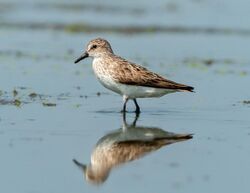Biology:Calidris
| Calidris | |
|---|---|

| |
| Semipalmated sandpiper (Calidris pusilla), Jamaica Bay Wildlife Refuge | |
| Scientific classification | |
| Domain: | Eukaryota |
| Kingdom: | Animalia |
| Phylum: | Chordata |
| Class: | Aves |
| Order: | Charadriiformes |
| Family: | Scolopacidae |
| Genus: | Calidris Merrem, 1804 |
| Type species | |
| Tringa calidris[1] = Tringa canutus Gmelin, 1789
| |
Calidris is a genus of Arctic-breeding, strongly migratory wading birds in the family Scolopacidae. These birds form huge mixed flocks on coasts and estuaries in winter. Migratory shorebirds are shown to have decline in reproductive traits because of temporal changes of their breeding seasons(Weiser et al., 2018). They are the typical "sandpipers", small to medium-sized, long-winged and relatively short-billed.
Their bills have sensitive tips which contain numerous corpuscles of Herbst. This enables the birds to locate buried prey items, which they typically seek with restless running and probing.[2]
Taxonomy
The genus Calidris was introduced in 1804 by the German naturalist Blasius Merrem with the red knot as the type species.[3][4] The genus name is from Ancient Greek kalidris or skalidris, a term used by Aristotle for some grey-coloured waterside birds.[5]
The genus contain 24 species:[6]
- Great knot, Calidris tenuirostris
- Red knot, Calidris canutus
- Surfbird, Calidris virgata
- Ruff, Calidris pugnax
- Broad-billed sandpiper, Calidris falcinellus
- Sharp-tailed sandpiper, Calidris acuminata
- Stilt sandpiper, Calidris himantopus
- Curlew sandpiper, Calidris ferruginea
- Temminck's stint, Calidris temminckii
- Long-toed stint, Calidris subminuta
- Spoon-billed sandpiper, Calidris pygmaea
- Red-necked stint, Calidris ruficollis
- Sanderling, Calidris alba
- Dunlin, Calidris alpina
- Rock sandpiper, Calidris ptilocnemis
- Purple sandpiper, Calidris maritima
- Baird's sandpiper, Calidris bairdii
- Little stint, Calidris minuta
- Least sandpiper, Calidris minutilla
- White-rumped sandpiper, Calidris fuscicollis
- Buff-breasted sandpiper, Calidris subruficollis
- Pectoral sandpiper, Calidris melanotos
- Semipalmated sandpiper, Calidris pusilla
- Western sandpiper, Calidris mauri
References
- ↑ "Scolopacidae". The Trust for Avian Systematics. https://www.aviansystematics.org/4th-edition-checklist?viewfamilies=59.
- ↑ Nebel, S.; Jackson, D.L.; Elner, R.W. (2005). "Functional association of bill morphology and foraging behaviour in calidrid sandpipers". Animal Biology 55 (3): 235–243. doi:10.1163/1570756054472818. http://publish.uwo.ca/~snebel2/nebel05AnimBiol.pdf. Retrieved 2016-06-03.
- ↑ Merrem, Blasius (8 June 1804). "Naturgeschichte" (in German). Allgemeine Literatur-Zeitung 168: Col. 542. https://api.digitale-sammlungen.de/iiif/presentation/v2/bsb10502034/canvas/453/view. Published anonymously.
- ↑ Peters, James Lee, ed (1934). Check-List of Birds of the World. 2. Cambridge, Massachusetts: Harvard University Press. p. 280. https://www.biodiversitylibrary.org/page/14483093.
- ↑ Jobling, James A (2010). The Helm Dictionary of Scientific Bird Names. London: Christopher Helm. p. 84. ISBN 978-1-4081-2501-4. https://archive.org/details/Helm_Dictionary_of_Scientific_Bird_Names_by_James_A._Jobling.
- ↑ Gill, Frank; Donsker, David, eds (2019). "Sandpipers, snipes, coursers". World Bird List Version 9.2. International Ornithologists' Union. https://www.worldbirdnames.org/bow/sandpipers/.
Weiser, E. L., Brown, S. C., Lanctot, R. B., Gates, H. R., Abraham, K. F., Bentzen, R. L., Bêty, J., Boldenow, M. L., Brook, R. W., Donnelly, T. F., English, W. B., Flemming, S. A., Franks, S. E., Gilchrist, H. G., Giroux, M.-A., Johnson, A., Kennedy, L. V., Koloski, L., Kwon, E., & Lamarre, J.-F. (2018). Life‐history tradeoffs revealed by seasonal declines in reproductive traits of Arctic‐breeding shorebirds. Journal of Avian Biology., 49(2). https://doi.org/10.1111/jav.01531
Wikidata ☰ Q30838 entry
 |

